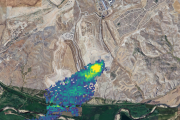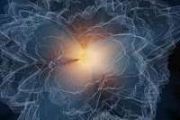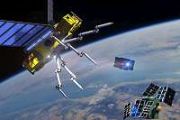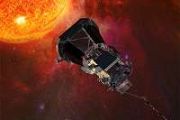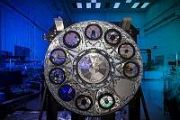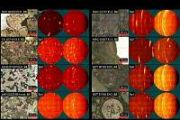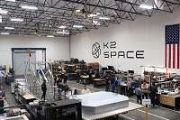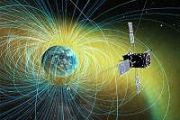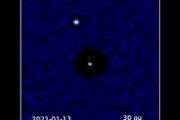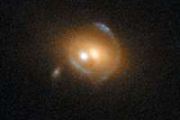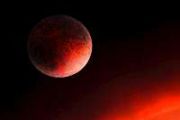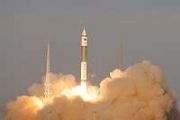
Copernical Team
"Seafloor fertilizer factory" helped breathe life into Earth
 Scientists reveal a new part of the recipe for complex life on planets, and it involves the onset of a microbial fertilizer factory on the Earth's seafloor roughly 2.6 billion years ago.
The first major rise in oxygen levels on the Earth took place roughly 2.4 to 2.2 billion years ago during the early stage of the Great Oxidation Event.
Scientists are still unsure why and how the Gre
Scientists reveal a new part of the recipe for complex life on planets, and it involves the onset of a microbial fertilizer factory on the Earth's seafloor roughly 2.6 billion years ago.
The first major rise in oxygen levels on the Earth took place roughly 2.4 to 2.2 billion years ago during the early stage of the Great Oxidation Event.
Scientists are still unsure why and how the Gre Icesat-2 data shows Arctic sea ice thinning in just three years
 Over the past two decades, the Arctic has lost about one-third of its winter sea ice volume, largely due to a decline in sea ice that persists over several years, called multiyear ice, according to a new study. The study also found sea ice is likely thinner than previous estimates.
Seasonal sea ice, which melts completely each summer rather than accumulating over years, is replacing thicke
Over the past two decades, the Arctic has lost about one-third of its winter sea ice volume, largely due to a decline in sea ice that persists over several years, called multiyear ice, according to a new study. The study also found sea ice is likely thinner than previous estimates.
Seasonal sea ice, which melts completely each summer rather than accumulating over years, is replacing thicke Wildfire Workshop Accelerates NASA Firefighting Solutions
 In a changing climate, wildfires are becoming more widespread and devastating, threatening more people and land than ever before. In response, NASA is stepping up to the plate to determine what we can do to help fight wildfires - and we have some ideas.
NASA has long been involved in wildfire management through the Science Mission Directorate (SMD) using space-based technologies and other
In a changing climate, wildfires are becoming more widespread and devastating, threatening more people and land than ever before. In response, NASA is stepping up to the plate to determine what we can do to help fight wildfires - and we have some ideas.
NASA has long been involved in wildfire management through the Science Mission Directorate (SMD) using space-based technologies and other Chief designer details China's future lunar missions
 China will carry on its moon research in the future with Chang'e-6, Chang'e-7 and Chang'e-8 missions by 2030, chief designer of the country's lunar exploration program Wu Weiren said.
The Chang'e-6 is scheduled to bring back to Earth lunar samples with a mass of up to 2 kilograms; the Chang'e-7 will be tasked with landing on the lunar south pole and detecting local natural resources; and t
China will carry on its moon research in the future with Chang'e-6, Chang'e-7 and Chang'e-8 missions by 2030, chief designer of the country's lunar exploration program Wu Weiren said.
The Chang'e-6 is scheduled to bring back to Earth lunar samples with a mass of up to 2 kilograms; the Chang'e-7 will be tasked with landing on the lunar south pole and detecting local natural resources; and t Scientists develop a new model of a fundamental process of Earth's global dynamics
 The tectonic plates that form the Earth's surface are like puzzle pieces that are in constant, very slow motion - on average, they move only up to around 10 centimeters a year. But these puzzle pieces don't quite fit together: there are zones on one plate that end up plunging under another - the so-called subduction zones, central to the dynamics of the planet. This movement is slow, but it can
The tectonic plates that form the Earth's surface are like puzzle pieces that are in constant, very slow motion - on average, they move only up to around 10 centimeters a year. But these puzzle pieces don't quite fit together: there are zones on one plate that end up plunging under another - the so-called subduction zones, central to the dynamics of the planet. This movement is slow, but it can Sanctions against Russia could provide opportunities for India's space sector
 Industry experts say US and European economic sanctions against Russia for military action against Ukraine could create economic opportunities for the Indian space sector, rather than burden it with economic costs.
He also felt that to seize the opportunity, India should accelerate its satellite launching capabilities, and announce Productivity Concessions (PLI) schemes for the aerospace s
Industry experts say US and European economic sanctions against Russia for military action against Ukraine could create economic opportunities for the Indian space sector, rather than burden it with economic costs.
He also felt that to seize the opportunity, India should accelerate its satellite launching capabilities, and announce Productivity Concessions (PLI) schemes for the aerospace s Arecibo Observatory reopens visitor center after telescope collapse
 The famous Arecibo Observatory in Puerto Rico, once home to the world's most powerful radio telescope, has reopened to visitors more than a year after the giant facility collapsed.
The visitor center and observation deck are now open to visitors who make reservations in advance. From the outdoor deck, visitors can see the valley and remaining reflective dish - 1,000 feet in diameter. /
The famous Arecibo Observatory in Puerto Rico, once home to the world's most powerful radio telescope, has reopened to visitors more than a year after the giant facility collapsed.
The visitor center and observation deck are now open to visitors who make reservations in advance. From the outdoor deck, visitors can see the valley and remaining reflective dish - 1,000 feet in diameter. / China plans more planetary endeavors: scientist
 After the Tianwen-1 mission, China will have a number of Tianwen series of planetary endeavors to explore the universe, according to a Chinese scientist.
Wu Weiren, the chief designer of China's lunar exploration program, said the country's deep space exploration will continue and its Mars mission will be followed by the Tianwen-2, Tianwen-3, and Tianwen-4.
Launched on July 23, 2020,
After the Tianwen-1 mission, China will have a number of Tianwen series of planetary endeavors to explore the universe, according to a Chinese scientist.
Wu Weiren, the chief designer of China's lunar exploration program, said the country's deep space exploration will continue and its Mars mission will be followed by the Tianwen-2, Tianwen-3, and Tianwen-4.
Launched on July 23, 2020, China planning global system for precision meteorological monitoring
 China is planning the construction of a new global system for gathering high-precision meteorological data based on the interpretation of signals beamed down from satellites, according to the second institute of the China Aerospace Science and Industry Corporation Ltd. (CASIC).
The "global occultation meteorological detection constellation" will measure the frequency, phase and amplitude o
China is planning the construction of a new global system for gathering high-precision meteorological data based on the interpretation of signals beamed down from satellites, according to the second institute of the China Aerospace Science and Industry Corporation Ltd. (CASIC).
The "global occultation meteorological detection constellation" will measure the frequency, phase and amplitude o In-orbit construction of China's space station going smoothly
 Construction work on the core module of China's Tiangong space station is proceeding steadily, the China Manned Space Agency (CMSA) said on Friday.
The Shenzhou-13 mission astronauts currently working the project are all in good condition, said the CMSA, adding that they plan to return to Earth in April.
The key technologies for the construction of the space station have been fully v
Construction work on the core module of China's Tiangong space station is proceeding steadily, the China Manned Space Agency (CMSA) said on Friday.
The Shenzhou-13 mission astronauts currently working the project are all in good condition, said the CMSA, adding that they plan to return to Earth in April.
The key technologies for the construction of the space station have been fully v 









